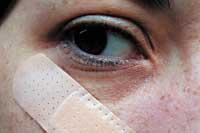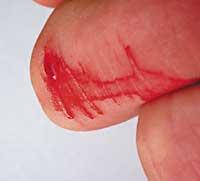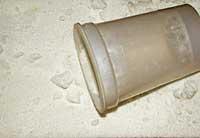First aid at home
Choking

Normally it is children who, when they play or walk, swallow some strange body and, instead of going down to the stomach, it remains in the larynx or in sincerity. Choking can be very serious. In most cases, through coughing, the child expels the foreign body out, but if not, we should immediately put it up on a chair, for example, or on our hillside, catching it from the waist. And between the shoulder bones or shoulder blades we give him the slaps, with his hand open, until we throw him the strange body.
In more children or adults, we have to keep the patient behind us, surrounding with both arms his chest, as if we gave him a hug, holding with our hands to the other and exerting a sudden and hard pressure against the ribs. This procedure is known as a Heimlich maneuver and the foreign body is expelled as a result of cough.
However, in case of failure of the aforementioned systems, you must immediately go to the nearest healthcare center, hospital or health center.
Fractures
Also fractures or bone locations are quite frequent. In these cases it is necessary to immobilize the injured limb at the site of the accident, since what is initially a closed and simple fracture can become an open fracture if bone fragments are mobilized, considerably complicating the case.
Never try to place the broken bone in place, as this way we will only make the injury worse. What needs to be done is to support the broken limb with boards to avoid internal injuries to the cutting corners of the bone.
If the injured limb is an arm, the arm will be immobilized using a wooden board, a branch, a piece of hard cardboard or, if there is no other, a newspaper folded several times, holding it with a cloth, rag or a headscarf or neck and hanging it from the neck.

When the broken limb is the leg, to immobilize it can be used two poles or poles or two wooden boards or boards, attached in 3 or 4 positions on each side of the limb. Between the skin and the object used for immobilization will always be placed a hydrophilic cotton (or otherwise a soft fabric or fabric) and once the immobilization has been achieved will be transferred to the hospital the injured.
Wounds
When a wound occurs we must clean the whole environment, but first we must wash our hands. Then we leave the injured body part without clothes; if the wound is small and superficial, it is enough to wash it with tap water, give it a little mercromine and cover it with a gauze or spread it (usually enough a bandage).
If the wound or cut is deep, we should not clean it or give it any cream or powder. It is best that the injured person be immediately transferred to the doctor for the first cure. But if the wound has occurred in a dirty place, or where animals circulate, do not forget the danger of tetanus. So check if the vaccination is old or not, and tell your doctor.
Bleeding
When bleeding occurs, check how the blood comes out first. If the blood is intense red and is periodically extracted as a blasting, a tourniquet or firm joint will be placed in the injured vessel, above the wound (but not at the same level) with a rubber band or a strip of fabric or, failing that, joining very closely with a shoe cord, while pressing on the bleeding tube with the fingers.
The tourniquet should relax periodically (every eight to ten minutes, for 30-45 seconds) so that the part of the member that is left without blood can receive blood. Otherwise, a gangrene may occur.
So tourniquet is an austerity measure that should be done to a person who hopes to receive better medical care to survive.
Ear pain
Ear pain is almost always due to a bacterial disease, so it is advisable to go to the specialist as soon as possible. And it must be said that oil drops so easy and extensive that are recommended are more harmful than beneficial. They can damage the eardrum and also make it harder for the doctor to work later if you want to see the ear.
To "relieve" the ear pain, not to cure it, of course, the best is dry heat. Fill a bag of sand or salt, heat it slightly and put it a few minutes on top of the ear that we have pain.
Poisoning

Obviously, the first thing to ask the person is what he has taken, if possible. But if the person is unconscious, he or she must lie sideways or face down so that the airways are free.
If possible, the container of the toxic product will be stored for further analysis. For these relatively frequent intoxications:
- Soaps, detergents. Do not cause vomiting as there is a risk of choking. Do not give anything to drink. To avoid foaming it is advisable to apply cubes or candies.
- Alcohol. Cause vomiting as soon as possible.
- Bleach and caustic acids. Give plenty of milk, preferably mixed with clear 5-9 eggs. If there is no milk, give any other liquid. Avoid vomiting whenever possible.





